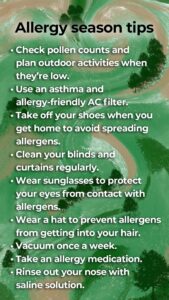From KUT:
For folks moving to Austin, experiencing the first brush with cedar fever is practically a rite of passage. Griping about allergies is a sacred activity that unites the newbies with folks born-and-raised in Austin. So when a report was released this month that boldly declared Austin’s allergies aren’t that bad compared to other cities, it unsurprisingly stirred up some strong reactions on social media.
The Allergy & Asthma Foundation of America’s annual Allergy Capitals report ranks U.S. cities by how challenging they are for people with allergies. Out of the 100 most populous U.S. metropolitan areas, Austin ranked 96. Put another way, Austin was ranked the fourth least challenging.

Gabby Rodriguez Illustration / KUT
This is difficult information for Austinite Malia Lewin to square. She’s lived in cities all across the country and says Austin has triggered her allergies by far the most.
“I took a taxi from the airport to the hotel — it was actually before I moved here — and the cab driver said, ‘Don’t fall in love with it if you have allergies,’” Lewin said.
She fell in love with Austin anyway. Now, Lewin uses allergy medicine year-round — sometimes three kinds at once in the springtime, plus her inhaler.
Austin’s rankings were also a surprise to Austinite John Paul Dingens, who admits his allergies are comparatively mild. He experienced his first rough cedar fever season around three years after moving to Austin from Michigan, where he rarely had a sniffle.
“It’s surprising because you hear so many people complain,” Dingens said.
So, are these experiences merely anecdotal? Do Austinites really just enjoy complaining about allergies?
An extra season of sneezes
Dr. Allen Lieberman, an allergist at Austin Family Allergy & Asthma, wants to affirm that allergies in Austin actually are rough, despite what a cursory glance at the AAFA rankings might imply.
“Most parts of the country have two major pollen seasons. Austin has three seasons, where we have fall, winter and spring,” he said. “So just by function of having one extra allergy season, it really puts us in the top category.”
That added season — winter — is when Ashe juniper tree pollen, which triggers what we call cedar fever, is most active.
However, the sheer number of days Austinites experience allergies is not what the Allergy Capitals report captures. AAFA’s research team used three criteria to compare cities: pollen counts, the prevalence of over-the-counter allergy medication use and the number of board-certified allergists available per an estimated number of allergy sufferers.
While Austin scored about average in the pollen category, it had relatively few people using over-the-counter medications. The city does have a strong availability of allergy specialists, which Lieberman said could explain why statistically fewer people are using medications like Claritin and Zyrtec.
This factor is why Austin was ranked as less challenging for allergy sufferers than certain other cities, like Atlanta. Even though Atlanta has less pollen than Austin, residents there have access to fewer allergists and are reaching for over-the-counter medication more often.
Limitations
Hannah Jaffe, AAFA’s research manager, acknowledged there are some limitations to the data her team used. National data can’t account for certain local variables, making it difficult to compare cities in disparate regions. For instance, certain types of pollen are more allergenic than others. But AAFA considered only the amount of pollen, not how allergenic it is.
“An example of this is pine pollen. It’s not considered to be too allergenic, but you might see days where the pollen count is really high,” Jaffe said. “But when it comes to the impact on people’s allergy symptoms, since it’s not allergenic, it might not have that much of an impact.”
On the flip side, Ashe juniper pollen packs a major punch, according to Lieberman and other experts.
There’s another cedar-related hole in this report as well. Pollen Sense, which provides AAFA with pollen count data, did not provide data from Jan. 1-19, 2022, because many pollen sensors were offline following the holiday season. According to Alison Baylis, an urban ecologist with Texas A&M Forest Service, early January is the most active time of year for cedar fever.
“If that critical date period is missing, it might influence our ranking to make us appear better than we actually are, at least from the [tree pollen] perspective,” Baylis said.
Ultimately, both Jaffe and local experts agree that no report can entirely sum up allergy severity. Different methodologies yield different results; for instance, a separate 2021 study ranked Austin as the U.S. city with the most tree pollen allergy potential.
Jaffe is also quick to say that AAFA’s list won’t give anyone an idea of their personal sensitivities.
“We certainly don’t want people to use this as a sort of guide to where they should move,” she said, “because we know that when people move, they can develop new allergies to new types of pollen that they weren’t previously exposed to.”
Tips and cautions
Rankings aside, Lieberman said AAFA’s report includes some helpful data on how to manage pollen allergies: avoid the outdoors during active allergy seasons, take allergy medicine and rinse out your nose, and turn to an allergist for immunotherapy if allergies persist.
The report also touches on the effect of climate change on allergies, which Lieberman agrees is a significant issue. Rising temperatures and increased carbon dioxide are causing pollen season to start sooner, beginning 20 days earlier and lasting 10 days longer than 30 years ago.
“So far, the tree pollen season started really early this year. Even bluebonnets — not that bluebonnets cause allergies — were out at the end of February. And we started seeing a significant rise in tree pollen in early March, probably two weeks early,” he said. “So not only are the seasons trying to get longer, but the pollen is going to become more significant, too.”
In the midst of these concerning changes, Lieberman gives Austinites the OK to complain about their allergies, regardless of where the city falls on a list.
“It’s kind of a matter of pride,” he said. “Everyone kind of suffers together.”













